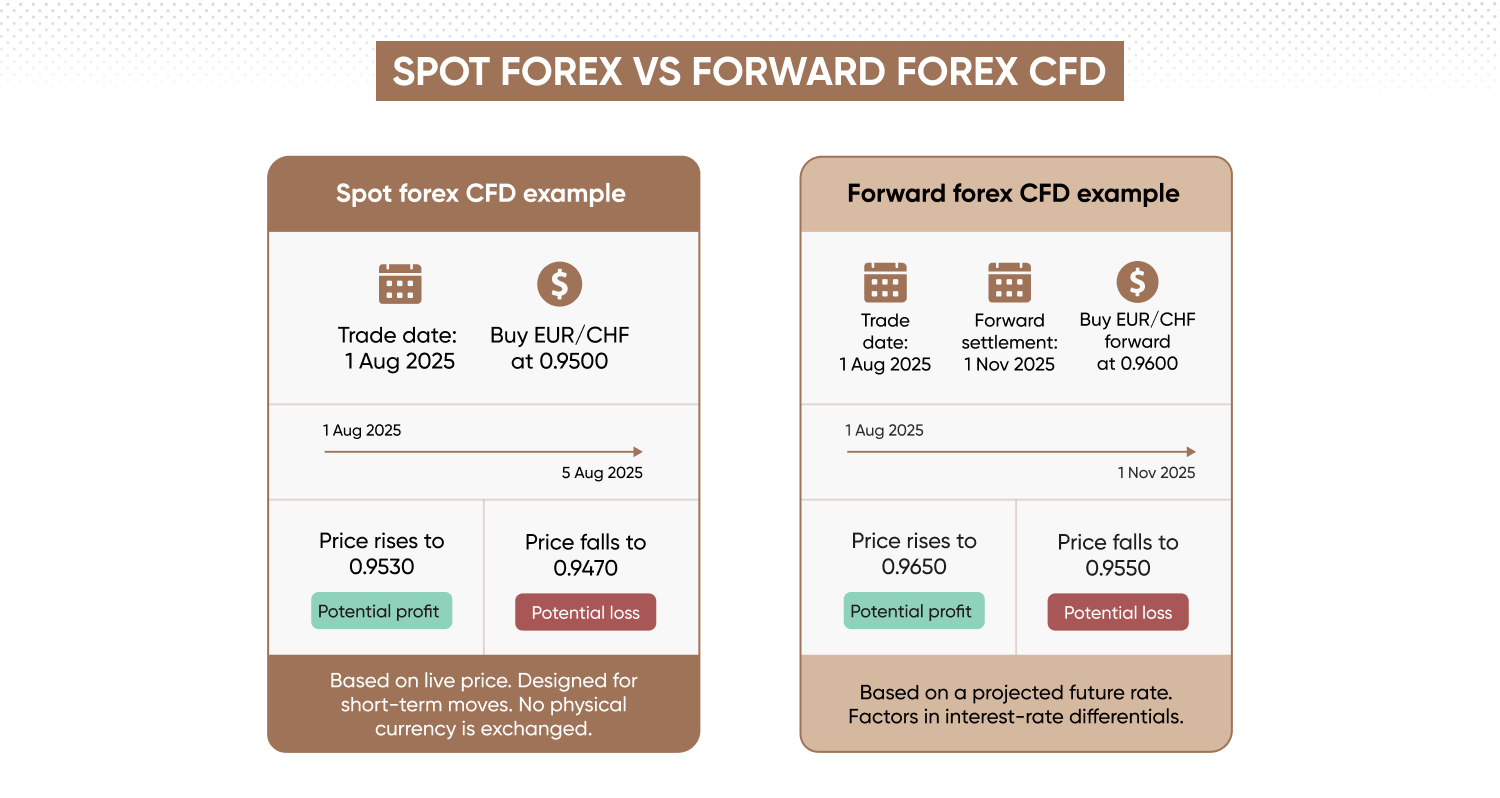Forex CFDs: Understanding currency forwards vs spot markets
Spot or forward? These two forex markets behave differently, and now you can trade both with us as forex CFDs. Here’s how they work, and what sets them apart.
Newly listed forex CFDs such as EUR/CHF forward and EUR/NOK forward enable traders to explore macro themes, hedge exposure, or speculate on future exchange rates. But how exactly do currency forwards differ from spot markets – and what role do CFDs play in this dynamic?
This guide explains the difference between spot rate vs forward rate trading in forex, and how forex CFDs allow you to access both. Whether you're exploring Swedish krona or Swiss franc pairs, this is your gateway to understanding spot vs forward markets.
What are CFDs in forex?
A contract for difference (CFD) in forex lets you speculate on currency price movements without owning the actual currencies. Rather than buying or selling physical EUR, USD, or CHF, you trade on the difference in price between the time you open and close a position.
Forex CFDs are popular because they offer:
- Leverage: also known as margin trading, leverage magnifies exposure with less upfront capital. This amplifies potential losses as well as profits, making it risky.
- Long or short opportunities: trade rising or falling prices.
- No ownership: pure speculation, no need to convert currencies.
Learn more by reading our guide – what is CFD trading?
What is the spot rate in forex?
The spot rate is the current exchange rate of a currency pair – essentially the price you would pay right now for immediate delivery. In trading terms, spot CFD forex markets reflect real-time supply and demand in the global currency market.
Key traits of spot markets
- Based on live market pricing
- High liquidity and tight spreads (particularly for major pairs like EUR/USD)
- React quickly to news, economic data, and interest-rate decisions
Spot forex CFDs mirror this live action, making them suitable for short-term strategies and momentum-based trading.
What is forex trading? Learn more with our explainer guide – or discover the comparison of CFDs vs forex trading.
What are forward forex CFDs?
Forward forex CFDs are based on the expected price of a currency pair at a future date, typically factoring in interest-rate differentials between the two currencies.
Forwards are agreements to exchange currencies at a specified rate on a set future date – commonly used by institutions and corporates for hedging. With forex forwards, you can now speculate on these longer-term expectations without needing a traditional forward contract.
Our newly listed forward CFDs include:
- EUR/CHF forward
- EUR/SEK forward
- EUR/NOK forward
- EUR/DKK forward
These can help you position around anticipated rate shifts, inflation trends, or macroeconomic policy decisions.
Spot rate vs forward rate: what's the difference?
The spot rate vs forward rate difference boils down to timing and pricing. While spot CFDs reflect the currency's current value, forward CFDs project where the market thinks the pair will be – based on the interest rate and yield curves.
This makes forward forex CFDs potentially useful for traders with a longer-term view or those anticipating changes in central bank policy.
|
Feature |
Spot forex CFDs |
Forward forex CFDs |
|
Settlement |
Immediate |
Future date (eg, 1-3 months ahead) |
|
Pricing |
Based on current exchange rate |
Reflects spot + interest-rate spread |
|
Use case |
Short-term trading |
Hedging or macro positioning |
|
Market factors |
Live news, data, sentiment |
Rate differentials, expectations |
Example trade: spot vs forward forex CFD
Let’s explore some hypothetical trades to show the difference between spot and forward forex CFDs.
Suppose you’re watching EUR/CHF and you believe the euro will strengthen against the Swiss franc over the coming months. You want to go long – but you’re not sure whether to use a spot CFD or a forward CFD.
Spot forex CFD trade
EUR/CHF spot CFD
-
Trade date: 1 August 2025
-
Live price: 0.9500
-
Position: You go long (buy) 1,000 units
-
By 5 August 2025, the price rises to 0.9530, and you close your position.
However, if the price had dropped instead (eg to 0.9470), you would have taken a 30-pip loss.
Forward forex CFD trade
EUR/CHF forward CFD (November expiry)
-
Trade date: 1 August 2025
-
Forward rate: 0.9600
-
Position: You go long (buy) 1,000 units
-
This rate already includes interest-rate differentials between EUR and CHF
-
By 1 November 2025, if the forward price rises to 0.9650, you can close your position for a 50-pip gain
Your profit here reflects a longer-term view – you’re trading on the expected value of EUR/CHF in the future, shaped by macro trends like interest rate changes and central bank policy.
Again, if EUR/CHF falls to, say, 0.9550 by expiry, you’d incur a 50-pip loss instead.
Please note that these are just illustrative examples and do not reflect actual price action. Past performance is not a reliable indicator of future results.

What moves the price of forward forex CFDs?
While spot forex prices respond instantly to events, forward prices are shaped by deeper macro expectations. These may include:
- Interest-rate differentials: between central banks (eg, ECB vs SNB or Riksbank)
- Inflation outlooks: and their impact on monetary policy
- Political or economic uncertainty: that may affect long-term currency strength
- Market sentiment and carry trade dynamics
For example, if Norway is expected to cut interest rates while the eurozone holds steady, EUR/NOK forward CFDs may reflect this anticipated weakening of the NOK.
Why trade forward forex CFDs?
Here’s why some traders prefer forward forex CFDs:
- Longer-term macro exposure: align trades with rate cycle expectations
- Diversification: go beyond major currency pairs
- Strategic positioning: the potential to hedge business risk or test trading ideas
- Carry trades: exploit interest rate differentials built into the forward price
Keep in mind that with CFDs, you’re trading the price difference – not the actual delivery of currency at a future date.
Final thoughts – spot or forward?
The choice between spot and forward forex CFDs depends on your outlook, strategy, and market focus.
-
Short-term trader? Spot forex CFDs offer fast-moving action.
-
Macro-focused or hedging? Forward CFDs may provide a future-oriented view.
Understanding the spot rate vs forward rate difference is key to using both effectively. With Capital.com, you can trade both spot and selected forward currency pairs – on a platform designed for speed and flexibility.
Stay up to date with the major forex pairs using our currency strength meter.
FAQ
What are CFDs in forex?
Forex CFDs (contracts for difference) let you speculate on currency pair movements without owning the underlying currencies. Instead of buying or selling actual euros, dollars or francs, you trade on the price change between opening and closing a position. This allows for leveraged exposure and the flexibility to go long or short, depending on your view of the market. Be aware that leveraged trading amplifies both losses and potential profits, making it risky.
What is the difference between spot and forward forex CFDs?
Spot forex CFDs track the current exchange rate and many use the spot price for short-term trading. Forward forex CFDs, on the other hand, are based on the projected future price of a currency pair – typically factoring in interest-rate differentials between the two currencies. The key difference lies in timing: spot reflects today’s market price, while forwards look ahead.
Are forward forex CFDs good for trading interest-rate expectations?
Forward forex prices often include the expected difference in interest rates between two currencies, meaning they can be used to position around central bank decisions, macroeconomic forecasts, or monetary policy shifts. If you expect one central bank to raise rates faster than another, forward forex CFDs can help you trade that view.